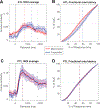Memorability of words in arbitrary verbal associations modulates memory retrieval in the anterior temporal lobe
- PMID: 32601459
- PMCID: PMC7501186
- DOI: 10.1038/s41562-020-0901-2
Memorability of words in arbitrary verbal associations modulates memory retrieval in the anterior temporal lobe
Abstract
Despite large individual differences in memory performance, people remember certain stimuli with overwhelming consistency. This phenomenon is referred to as the memorability of an individual item. However, it remains unknown whether memorability also affects our ability to retrieve associations between items. Here, using a paired-associates verbal memory task, we combine behavioural data, computational modelling and direct recordings from the human brain to examine how memorability influences associative memory retrieval. We find that certain words are correctly retrieved across participants irrespective of the cues used to initiate memory retrieval. These words, which share greater semantic similarity with other words, are more readily available during retrieval and lead to more intrusions when retrieval fails. Successful retrieval of these memorable items, relative to less memorable ones, results in faster reinstatement of neural activity in the anterior temporal lobe. Collectively, our data reveal how the brain prioritizes certain information to facilitate memory retrieval.
Conflict of interest statement
Competing Interests
The authors declare no competing interests.
Figures









References
-
- Unsworth N Individual differences in long-term memory. Psychol. Bull 145, 79–139 (2019). - PubMed
-
- Rubin DC Memorability as a measure of processing: A unit analysis of prose and list learning. J. Exp. Psychol. Gen 114, 213–238 (1985). - PubMed
-
- Bainbridge WA, Isola P & Oliva A The intrinsic memorability of face photographs. J. Exp. Psychol. Gen 142, 1323–1334 (2013). - PubMed
-
- Bainbridge WA, Dilks DD & Oliva A Memorability: A stimulus-driven perceptual neural signature distinctive from memory. Neuroimage 149, 141–152 (2017). - PubMed
Publication types
MeSH terms
Grants and funding
LinkOut - more resources
Full Text Sources
Other Literature Sources

